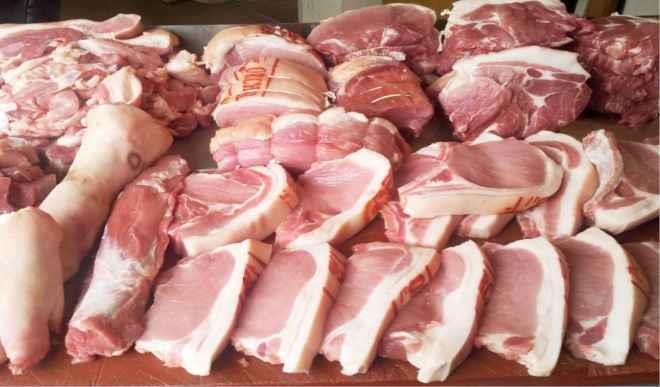
There are few animals in the English language that trump “pig” in poly-appellativeness. (“Poly-appellativeness” is my coinage for multiple names.) There are more than 10 alternative names for pig in English. This includes names that indicate gender (such as “boar” for male pig and “sow” and “gilt” for female pig) and names that indicate age (such as “piglet,” “farrow,” or “shoat/shote” for young pigs).
A pig is also called a“hog,” a“swine,” a“grunter,” a“squealer,” a“susscrofa,”a“porker,” and a“cobb roller.”There is probably more, but these are the names I can come up with for now.
Most people know “pork” as the culinary noun for meat from pig, but there are way more pig-based foods and meats than “pork” that several people, especially Muslims who are prohibited from eating pork, are not familiar with. This article is a public service for such people.
Another inspiration for this column derives from the tales of distress and guilt I’ve heard from many Muslim visitors to the West who consumed pig meat or who were awfully close to doing so out of ignorance ofthe deceptive appellative trappings of many pork-based gastronomic products.
For instance, at least five Muslims have told me that they either ate or almost ate a pig-based meat product called “salami” because they were deceived by the lexical similarities between “salami” and “salam” (Arabic for “peace”), and were misled into thinking they were eating halal meat.What could be more halal, they thought, than a meat that shares lexical and phonological similarities with “salaam,” the short form of the Muslim, Arabic-derived greeting,As-salamualaykum?
In fact, many African Muslims bear the name Salami as the short form of Abdulsalamor “Abdus Salam (which stands for servant of the Peaceful, Salam being one of the 99 names of Allah.) (Africans typically add a terminal vowel to every word or name. Thus, “Salam” becomes “Salami”).
So how did pig meat come to share lexical similarities with the name of Allah and/or the short form of the most common greeting among Muslims, especially given that pork is prohibited in Islam? Find out from my list of popular pork-based meats and foods below:
1. “Bacon”: This is usually served during breakfast at homes and in hotels-along with eggs and sausage. It’s thin, sliced, salted, fried and brownish pork. It’s one of the most traditional culinary treats in the West. It’s so central to the gastronomy of the West that it appears in idioms such as “bring home the bacon,” which means to be the breadwinner, to be responsible for one’s family’s material wellbeing.
Most people know that bacon is derived from pig, but I have met many Muslim visitors to America, especially from Nigeria, who don’t know this.It’s also less commonly called “flitch.”
2. “Banger”: This is chiefly British English. Banger is pork cut into tiny pieces, seasoned, and stuffed in casings. The usual name for this elsewhere is “sausage” (see 3 below). It appears in collocations such as “banger and beans,” “bangers and mash,” etc.
3. “Bratwurst (or just brat)”: Just like “banger” is chiefly British, “bratwurst” is mostly German. It’s a popular German pork sausage, although it’s often mixed with beef. In America bratwursts are called “brats.” (Sausage is any type of minced meat, mostly pork, that is seasoned and stuffed in casings).
4. “Chitlings” or “chitlins” or “chitterlings”: Most dictionaries define this word innocently as “small intestines of hogs prepared as food.” It’s way more than that. Here is what I wrote about it in a March 2, 2014 column titled, “Colloquial American English Expressions I Learned from Malcolm X” :
“In his inimitably classic distinction between a ‘field negro’ and a ‘house negro,’ Malcolm X said: ‘The Negro in the field didn’t get nothing but what was left of the insides of the hog. They call ’em ‘chitt’lin’’ nowadays. In those days they called them what they were: guts. That’s what you were – a gut-eater. And some of you are still gut-eaters.’
“I learned a few things from that quote. One, I learned that ‘hog’ is another word for ‘pig.’ It’s amazing how many words the English language has for pig: hog, swine, grunter, squealer, boar, Susscrofa, etc. Most other domestic animals have just one name.
“Well, I also learned that ‘chitlins’ means the intestines of a pig, which American blacks ate as food during slavery because it was one of the only few sources of protein available to them. Several decades after slavery, chitlins (also spelled chitlings and chitterlings) are an African-American delicacy.
“No one knows how the word ‘chitlins’ came about, but it’s now usual to use it to mean the intestines of any animal prepared as food. So what Yoruba people call ‘orisirisi,’ or what Nigerian English speakers call ‘assorted,’ that is, the cooked entrails of a cow, would qualify as ‘chitlins.’
If you are a Muslim who wants to experience African-American culinary delights, often called “soul food,” be sure to avoid “chitlings.” It’s just a cute word for the intestines of pigs.
From medieval England up until the 19th century, poor people also used to eat chitterlings. But they are now rare in the UK.
5. “Chops” or “pork chops”: I know “chop” means “eat” in West African Pidgin English. But in Standard English it can mean a small cut of meat. It usually, though, is a small cut of meat from cooked pig. That’s why the usual phrase is pork chops, but it is also frequently rendered as “chops,” and that’s where people unfamiliar with the culinary vocabularies of the West might be misled into thinking they are eating a small cut of beef or mutton, etc.
6. “Frank” or “Frankfurter”: This is type of smooth, minced, smoked pork often served in a bread roll. It is sometimes made of beef or a mixture of beef and pork. It’s generally called “hot dog,” especially in American English, and it’s so named because some people suspected that in Germany, where it was invented, dog meat was surreptitiously inserted into the meat since Germans ate dogs up until the 20th century. There was no firm proof that there was dog meat in hot dogs, but the name has stuck.
Other names for franks or Frankfurters are “dog,” “weenie,” “wiener,” “wienie,”and “wienerwurst.”Although hot dogs or Franks started in Germany, they have become a staple of American street cuisine.
Thankfully, there are now turkey hot dogs, beef hot dogs, and chicken hot dogs, but the most popular ones are the pork-based ones. It’s always good to ask before you buy.
7. “Gammon”: This is pork taken from the thighs of a pig. It’s derived from the Latin word “gamba,” which means leg. It’s also calledjambon or, more commonly, ham.
8. “Kielbasa”: This is the Polish word for pork-based sausage, which has achieved widespread acceptance in American English, especially in northeastern United States. It’s also called “Polish sausage” because it’s originally from Poland.
9. “Liverwurst”: Sometimes people in the West grind the liver of pigs and stuff them in casings. Germans call it leberwurst, which has been Anglicized to liverwurst. It’s also called “liver pudding” or “liver sausage.”Wurst, as you’ve probably guessed, is German for sausage.
10. “Rasher”: This another name for bacon. Note that because of increasing pressure from Muslims and Jews, there’s now bacon or rasher made entirely from beef, turkey, chicken, or goat. If in doubt, ask.
11. “Ribs (or baby back ribs)”: This is meat from the ribs of a pig. But the term can seem like a generic reference to the ribs of any animal.It is also called back ribs or loin ribs.
12. “Pancetta”: It is Italian pork, derived from the belly of the pig. It is dried, salted, and chemically processed.
13. “Peperoni”: Peperoni is a mixture of beef and pork. So peperoni pizza is pizza that is made with pepperoni. Two years ago, a Muslim high court judge from Osun State nearly ate peperoni pizza at a workshop for Nigerian judges that I facilitated here in the United States. I knew he was an observant Muslim because we prayed together and he shared concerns about the ubiquity of pork in Western culinary choices.
During lunch break, I saw him with slices of pepperoni pizzaamid several people. I beckoned to him to come immediately, but he was really hungry, so he said I should give him a few minutes to finish his food. I know enough Yoruba to know that pig is called “alede” and eat is “je.” I combined the words to make a sentence that I didn’t think made much sense. He jumped out of his seat instinctively and asked me in English if what he was about to eat contained pork. I answered in the affirmative.
He went to the bathroom and vomited,even though he hadn’t eaten anything. I felt sorry for him. He refused to eat or drink anything thereafter.
14. “Prosciutto”: As you’ve probably guessed, it’s also an Italian word. It is ham (see number 7 above) that has been dried and salted.
15. “Salami”: This is the pig meat that discombobulates most Muslims from non-Western societies. A Muslim who ate salami in ignorance told me he was sure that the choice of the name was a deliberate “Zionist plot to make Muslims eat pork.” That’s not true. First, Jews, like Muslims, are forbidden from eating pork. Second, thephonemic similarity between “salami” to “salaam” is actually accidental.
Salami is salted Italian pork sausage. According to etymology dictionaries, “salami” is derived from the Latin name for salt, which is “sal.” The Italian suffix “ame” is used to form collective nouns. For example, foglia, which means “leaf,” becomesfogliame when used as a collective noun. So salameactually literally means “salts,” but specifically salted meats. (“Salami” is the plural form of salame).The association of salami with salted pork came later.
Interestingly, the meat is called “salam” in Romanian, Bulgarian, and Turkish!
16. “Sowbelly”: It is salted pork cut from the belly. Other obvious names are “pork bellies” and “pork slab.”

 Join Daily Trust WhatsApp Community For Quick Access To News and Happenings Around You.
Join Daily Trust WhatsApp Community For Quick Access To News and Happenings Around You.


